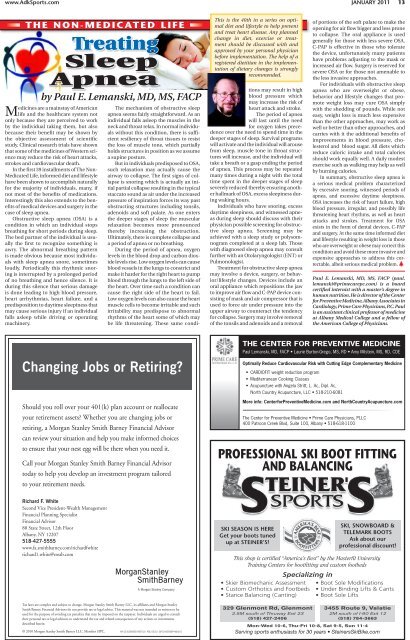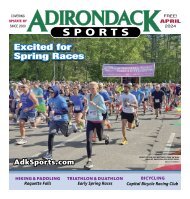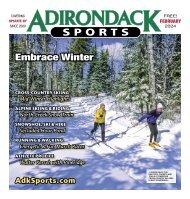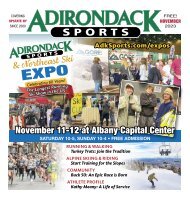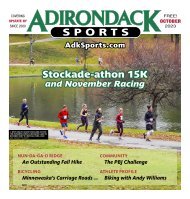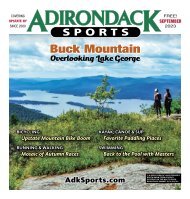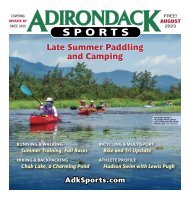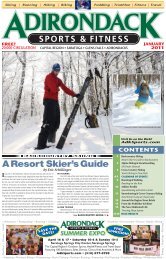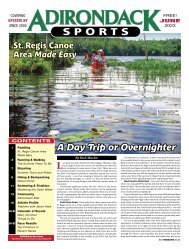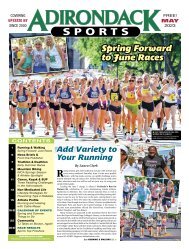ASF-2011-01
Create successful ePaper yourself
Turn your PDF publications into a flip-book with our unique Google optimized e-Paper software.
www.AdkSports.com JANUARY <strong>2<strong>01</strong>1</strong> 13<br />
THE NON-MEDICATED LIFE<br />
Treating<br />
Sleep<br />
Apnea<br />
by Paul E. Lemanski, MD, MS, FACP<br />
edicines are a mainstay of American<br />
Mlife and the healthcare system not<br />
only because they are perceived to work<br />
by the individual taking them, but also<br />
because their benefit may be shown by<br />
the objective assessment of scientific<br />
study. Clinical research trials have shown<br />
that some of the medicines of Western science<br />
may reduce the risk of heart attacks,<br />
strokes and cardiovascular death.<br />
In the first 39 installments of The Non-<br />
Medicated Life, informed diet and lifestyle<br />
have been shown to accomplish naturally<br />
for the majority of individuals, many, if<br />
not most of the benefits of medications.<br />
Interestingly this also extends to the benefits<br />
of medical devices and surgery in the<br />
case of sleep apnea.<br />
Obstructive sleep apnea (OSA) is a<br />
condition in which an individual stops<br />
breathing for short periods during sleep.<br />
The bed partner of the individual is usually<br />
the first to recognize something is<br />
awry. The abnormal breathing pattern<br />
is made obvious because most individuals<br />
with sleep apnea snore, sometimes<br />
loudly. Periodically this rhythmic snoring<br />
is interrupted by a prolonged period<br />
of no breathing and hence silence. It is<br />
during this silence that serious damage<br />
is done leading to high blood pressure,<br />
heart arrhythmias, heart failure, and a<br />
predisposition to daytime sleepiness that<br />
may cause serious injury if an individual<br />
falls asleep while driving or operating<br />
machinery.<br />
This is the 40th in a series on optimal<br />
diet and lifestyle to help prevent<br />
and treat heart disease. Any planned<br />
change in diet, exercise or treatment<br />
should be discussed with and<br />
approved by your personal physician<br />
before implementation. The help of a<br />
registered dietitian in the implementation<br />
of dietary changes is strongly<br />
recommended.<br />
The mechanism of obstructive sleep<br />
apnea seems fairly straightforward. As an<br />
individual falls asleep the muscles in the<br />
neck and throat relax. In normal individuals<br />
without this condition, there is sufficient<br />
resiliency of throat tissues to resist<br />
the loss of muscle tone, which partially<br />
holds structures in position as we assume<br />
a supine posture.<br />
But in individuals predisposed to OSA,<br />
such relaxation may actually cause the<br />
airway to collapse. The first signs of collapse<br />
is snoring which is actually an initial<br />
partial collapse resulting in the typical<br />
staccato sound as air under the increased<br />
pressure of inspiration forces its way past<br />
obstructing structures including tonsils,<br />
adenoids and soft palate. As one enters<br />
the deeper stages of sleep the muscular<br />
relaxation becomes more pronounced<br />
thereby increasing the obstruction.<br />
Ultimately, there is complete collapse and<br />
a period of apnea or no breathing.<br />
During the period of apnea, oxygen<br />
levels in the blood drop and carbon dioxide<br />
levels rise. Low oxygen levels can cause<br />
blood vessels in the lungs to constrict and<br />
make it harder for the right heart to pump<br />
blood through the lungs to the left side of<br />
the heart. Over time such a condition can<br />
cause the right side of the heart to fail.<br />
Low oxygen levels can also cause the heart<br />
muscle cells to become irritable and such<br />
irritability may predispose to abnormal<br />
rhythms of the heart some of which may<br />
be life threatening. These same conditions<br />
may result in high<br />
blood pressure which<br />
may increase the risk of<br />
heart attack and stroke.<br />
The period of apnea<br />
will last until the need<br />
for oxygen takes precedence<br />
over the need to spend time in the<br />
deeper stages of sleep. Survival programs<br />
will activate and the individual will arouse<br />
from sleep, muscle tone in throat structures<br />
will increase, and the individual will<br />
take a breath or a gasp ending the period<br />
of apnea. This process may be repeated<br />
many times during a night with the total<br />
time spent in the deeper stages of sleep<br />
severely reduced thereby ensuring another<br />
hallmark of OSA, excess sleepiness during<br />
waking hours.<br />
Individuals who have snoring, excess<br />
daytime sleepiness, and witnessed apneas<br />
during sleep should discuss with their<br />
physician possible screening for obstructive<br />
sleep apnea. Screening may be<br />
achieved with a sleep study or polysomnogram<br />
completed at a sleep lab. Those<br />
with diagnosed sleep apnea may consult<br />
further with an Otolaryngologist (ENT) or<br />
Pulmonologist.<br />
Treatment for obstructive sleep apnea<br />
may involve a device, surgery, or behavior/lifestyle<br />
changes. Devices include an<br />
oral appliance which repositions the jaw<br />
to improve air flow and C-PAP device consisting<br />
of mask and air compressor that is<br />
used to force air under pressure into the<br />
upper airway to counteract the tendency<br />
for collapse. Surgery may involve removal<br />
of the tonsils and adenoids and a removal<br />
of portions of the soft palate to make the<br />
opening for air flow bigger and less prone<br />
to collapse. The oral appliance is used<br />
generally for those with less severe OSA.<br />
C-PAP is effective in those who tolerate<br />
the device, unfortunately many patients<br />
have problems adjusting to the mask or<br />
increased air flow. Surgery is reserved for<br />
severe OSA or for those not amenable to<br />
the less invasive approaches.<br />
For individuals with obstructive sleep<br />
apnea who are overweight or obese,<br />
behavior and lifestyle changes that promote<br />
weight loss may cure OSA simply<br />
with the shedding of pounds. While not<br />
easy, weight loss is much less expensive<br />
than the other approaches, may work as<br />
well or better than other approaches, and<br />
carries with it the additional benefits of<br />
improvements in blood pressure, cholesterol<br />
and blood sugar. All diets which<br />
reduce caloric intake and total calories<br />
should work equally well. A daily modest<br />
exercise such as walking may help as well<br />
by burning calories.<br />
In summary, obstructive sleep apnea is<br />
a serious medical problem characterized<br />
by excessive snoring, witnessed periods of<br />
apnea, and excessive daytime sleepiness.<br />
OSA increases the risk of heart failure, high<br />
blood pressure, irregular, and possibly life<br />
threatening heart rhythms, as well as heart<br />
attacks and strokes. Treatment for OSA<br />
exists in the form of dental devices, C-PAP<br />
and surgery. At the same time informed diet<br />
and lifestyle resulting in weight loss in those<br />
who are overweight or obese may correct this<br />
condition and avoid these more invasive and<br />
expensive approaches to address this correctable,<br />
albeit serious medical problem.<br />
Paul E. Lemanski, MD, MS, FACP (paul.<br />
lemanski@primecarepc.com) is a board<br />
certified internist with a master’s degree in<br />
human nutrition. He is director of the Center<br />
for Preventive Medicine, Albany Associates in<br />
Cardiology, Prime Care Physicians, P.C. Paul<br />
is an assistant clinical professor of medicine<br />
at Albany Medical College and a fellow of<br />
the American College of Physicians.<br />
Changing Jobs or Retiring?<br />
Should you roll over your 4<strong>01</strong>(k) plan account or reallocate<br />
your retirement assets? Whether you are changing jobs or<br />
retiring, a Morgan Stanley Smith Barney Financial Advisor<br />
can review your situation and help you make informed choices<br />
to ensure that your nest egg will be there when you need it.<br />
Call your Morgan Stanley Smith Barney Financial Advisor<br />
today to help you develop an investment program tailored<br />
to your retirement needs.<br />
THE CENTER FOR PREVENTIVE MEDICINE<br />
Paul Lemanski, MD, FACP • Laurie Burton-Grego, MS, RD • Amy Milstein, MS, RD, CDE<br />
Optimally Reduce Cardiovascular Risk with Cutting Edge Complementary Medicine<br />
• CARDIOFIT weight reduction program<br />
• Mediterranean Cooking Classes<br />
• Acupuncture with Angela Stritt, L. Ac, Dipl. Ac,<br />
North Country Acupuncture, LLC • 518-210-6081<br />
More info: CenterforPreventiveMedicine.com and NorthCountryAcupuncture.com<br />
The Center for Preventive Medicine • Prime Care Physicians, PLLC<br />
400 Patroon Creek Blvd, Suite 100, Albany • 518-618-1100<br />
PROFESSIONAL SKI BOOT FITTING<br />
AND BALANCING<br />
Richard F. White<br />
Second Vice President-Wealth Management<br />
Financial Planning Specialist<br />
Financial Advisor<br />
80 State Street, 12th Floor<br />
Albany, NY 12207<br />
518-427-5555<br />
www.fa.smithbarney.com/richardfwhite<br />
richard1.white@mssb.com<br />
A Morgan Stanley Company<br />
Tax laws are complex and subject to change. Morgan Stanley Smith Barney LLC, its affiliates and Morgan Stanley<br />
Smith Barney Financial Advisors do not provide tax or legal advice. This material was not intended or written to be<br />
used for the purpose of avoiding tax penalties that may be imposed on the taxpayer. Individuals are urged to consult<br />
their personal tax or legal advisors to understand the tax and related consequences of any actions or investments<br />
described herein.<br />
© 2<strong>01</strong>0 Morgan Stanley Smith Barney LLC. Member SIPC. NY CS 6256950 RET<strong>01</strong>0 PSC 05/10 GP10-00936P-N04/10<br />
SKI SKI SEASON IS IS COMING HERE<br />
Get your boots tuned<br />
up at STEINER’S!<br />
SKI, SNOWBOARD &<br />
& TELEMARK BOOTS<br />
Ask about our<br />
professionals discount!<br />
This shop is certified “America’s Best” by the Masterfit University<br />
Training Centers for bootfitting and custom footbeds<br />
Specializing in<br />
• Skier Biomechanic Assessment • Boot Sole Modifications<br />
• Custom Orthotics and Footbeds • Under Binding Lifts & Cants<br />
• Stance Balancing (Canting) • Boot Sole Lifts<br />
329 Glenmont Rd, Glenmont 3455 Route 9, Valatie<br />
2.5M south of Thruway -Glenmont-<br />
Exit 23 2M south of I-90 Exit 12<br />
(518) 427-2406<br />
(518) 784-3663<br />
2.5 miles south of Thruway Exit 23 on Route 9W<br />
Mon-Wed 10-6, Thu-Fri 10-8, Sat 9-5, Sun 11-4<br />
(518) Serving S i 427-2406 sports t enthusiasts • i www t for f 30 steinerssports years • SteinersSkiBike.com<br />
i S com t


